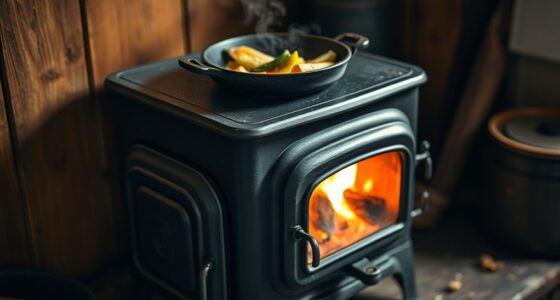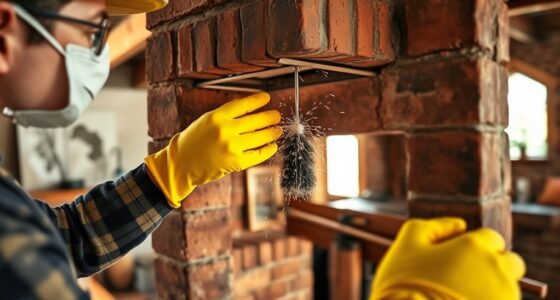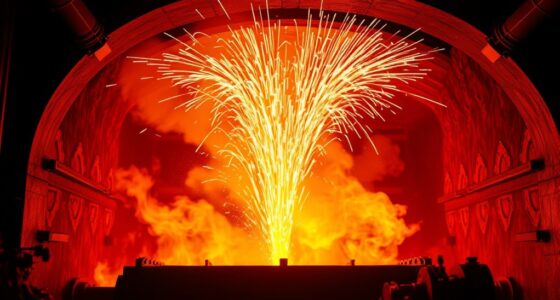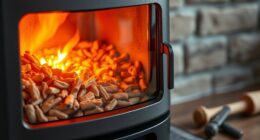Yes, wood stoves do produce creosote, a sticky, flammable residue that can build up inside your chimney and increase fire risks. To reduce creosote, burn only dry, seasoned wood with less than 20% moisture, and avoid burning trash or treated wood. Regularly inspect and clean your chimney, and use proper burning techniques for a hotter, cleaner fire. Keep exploring to discover more tips on keeping your stove safe and efficient.
Key Takeaways
- Yes, wood stoves produce creosote, a flammable residue from incomplete combustion of burning wood.
- Regular chimney inspections and cleanings prevent dangerous creosote buildup.
- Burning seasoned, dry wood with moisture below 20% reduces creosote formation.
- Proper fire-starting techniques and good airflow promote complete combustion, lowering creosote risks.
- Using tools like chimney brushes and avoiding trash or treated wood help minimize creosote accumulation.

Many wood stoves produce creosote when burning wood, which can pose safety risks if not properly managed. Creosote is a sticky, flammable residue that builds up inside your chimney over time. If left unchecked, it can lead to dangerous chimney fires or blockages, making regular chimney maintenance essential for safety. But beyond safety concerns, creosote buildup also impacts your stove’s fuel efficiency. When your chimney is coated with creosote, it hampers proper airflow, causing your stove to burn less efficiently and consume more wood to generate the same amount of heat. That means you spend more on fuel and get less warmth from your fire, which defeats the purpose of using a wood stove as an eco-friendly and cost-effective heating option.
To reduce creosote formation, you need to focus on both how you burn your wood and how you care for your chimney. Proper chimney maintenance is crucial, so schedule regular inspections and cleanings with a professional. This keeps the flue clear of creosote and debris, ensuring that smoke and gases flow smoothly. During the heating season, check your chimney for signs of creosote buildup, such as black soot or a tar-like substance. If you notice these, it’s time for a professional cleaning. Additionally, investing in a chimney brush and cleaning kit allows you to perform small, routine cleanings yourself, especially if you’re comfortable doing so. Regular cleaning and proper burning techniques can significantly reduce creosote buildup, lowering the risk of fires and improving stove efficiency.
Fuel efficiency is closely tied to your burning habits. To minimize creosote production, always burn seasoned, dry wood with a moisture content below 20%. Wet or green wood produces more smoke and creosote because the excess moisture causes incomplete combustion. Also, avoid burning trash, treated wood, or paper, which can produce more soot and creosote. Start your fires with kindling and small, dry splits, and allow the fire to establish a hot, clean burn before adding larger logs. Maintaining a good airflow ensures complete combustion, reducing creosote formation. Using a wood stove with a catalytic converter or airwash system can further improve burning efficiency, which in turn lessens creosote buildup.
Frequently Asked Questions
Can Creosote Buildup Cause Chimney Fires?
Yes, creosote buildup can cause chimney fires if not attended to. When you neglect regular chimney inspections, creosote accumulates, increasing the fire risk. Creosote is highly flammable, and a thick layer can ignite from the heat of a fire, leading to dangerous chimney fires. To prevent this, schedule regular chimney inspections, clean your stove thoroughly, and ensure proper venting to reduce creosote buildup and lower fire risks.
How Often Should I Clean My Wood Stove Chimney?
You should clean your wood stove chimney at least once a year, or more often if you notice smoke, odors, or reduced draft. Regular chimney inspections help identify buildup early, ensuring safety and efficiency. To keep creosote at bay, schedule cleaning frequency accordingly, especially with frequent or heavy fires. By staying proactive, you prevent dangerous blockages, protect your home, and enjoy a warm, safe fire season.
Are Certain Types of Wood More Likely to Produce Creosote?
Certain types of wood, especially softwoods like pine and cedar, are more likely to produce creosote because they have higher moisture content and burn hotter, which creates more smoke and tar. Hardwoods such as oak and maple tend to produce less creosote since they have lower moisture levels and burn more efficiently. To reduce creosote buildup, always dry your wood properly and avoid burning green or wet wood.
Does Burning Seasoned Wood Reduce Creosote Formation?
Burning seasoned wood definitely helps reduce creosote formation. When you use seasoned wood, it burns more completely, producing less smoke and fewer creosote deposits inside your stove and chimney. The theory that seasoned wood minimizes creosote is true because it has lower moisture content, leading to higher combustion temperatures. To maximize creosote reduction, make certain your wood is properly dried—ideally for at least 6-12 months—before burning.
What Are the Signs of Dangerous Creosote Buildup?
You’ll notice dangerous creosote buildup if you see thick, black soot or shiny, tar-like deposits in your chimney. Also, frequent chimney cleaning or chimney maintenance can reveal creosote layers. If your chimney smells smoky or you experience slow-burning fires, it’s a sign of buildup that poses fire safety risks. Address these issues promptly to prevent chimney fires, and always schedule regular inspections to keep your stove safe.
Conclusion
So, yes, wood stoves do produce creosote, but you hold the brush to keep it at bay. Regularly burning seasoned wood, maintaining proper airflow, and cleaning your chimney prevent creosote buildup like a shield guarding your home. Think of it as tending a garden—you need to prune and care for it to stay healthy. With a little effort, you can enjoy cozy fires without letting creosote turn your stove into a ticking time bomb.










